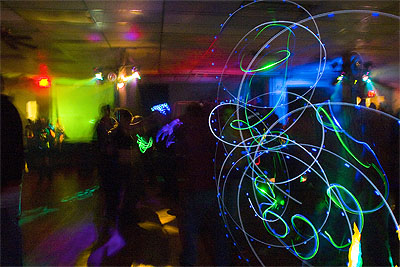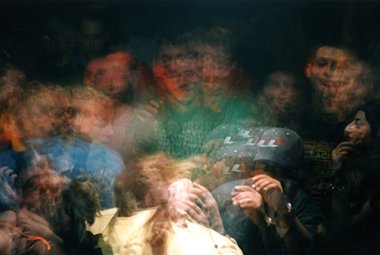Serendip is an independent site partnering with faculty at multiple colleges and universities around the world. Happy exploring!
Synesthesia and Perception

|
The Brain Constructing the World
A collaboration between Serendip and Painted Bride Art Center,
associated with the Synesthesia exhibit, April 3rd - May 16th 2009
Making sense of a "great blooming buzzing confusion"...
|
|
|
Special new exhibit
Additional Serendip resources Illusions, Ambiguous Figures, and Impossible Figures Cezanne and Beyond... and Back Again Art & Science Guest Exhibitions Commentaries on Synesthesia: 1, 2, 3, 4, 5, 6, 7, 8, 9, 10 Resources on the web Adventure to the Stars ... Telling Tales of Science and ArtTactile illusions: seven ways to fool your sense of touch When the Senses Become Confused COLORFULLanguage... the diary of a synaesthete People Hear With Skin as Well as Their Ears (see also Aero-tactile integration in speech perception) |
||||||||||||||
| Painted Bride Synesthesia Blog | On-line Forum |














Comments
ASMR
Someone already mentioned Autonomous Sensory Meridian Response and I believe they are valid. Anyways these exhibits remind me of the early days in experimental film where the senses were the most important part of any audio visual presentation. They rented out atriums and projected 16mm film towards the ceilings. I only wish I was a part of those experiences. Now raves and concerts seem like they are the last line of popular experimental media presentations. Anyways, if you haven't seen any of the ASMR films they promise to be inspiring,
ASMR
A newer phenomenon, or trend is Autonomous Sensory Meridian Response. Apparently it shares very similar caharacteristics to synethesia.
Very interesting comments
Very interesting comments here. I realize it's a bit late, but I can't help but offer my opinion on the way that synesthesia affects perception. Many known synesthetes have been tested and retested, and while much has been revealed, there is still much left to learn. For the purpose of art, though, I think that it can be quite beneficial to perceive our creations not much differently than a synesthete would. The most placating piece of art is one that placates the most senses.
synesthesia and the brain
Will have to go and see for myself
I am very interested in the Synesthesia exhibition and plan to take it in. I will be going with guarded optimism however because the link http://paintedbride.org/first-friday-synesthesia/ makes me think of what a rave or LSD experience might be like rather than anything to do with synesthesia.
"Guest curator Anabelle Rodriguez brings together a kaleidoscopic array of local and national artists who consider the scientific phenomenon of synesthesia, the blending of the senses."
The description above coupled with the posted pieces from the exhibit make me wonder:
1) if all of the displayed works are simply "considerations" based on research/observations by non-synesthete artists -or- if any of the artists are actually synesthetes of one type or another.
2) what does the Synesthesia exhibition intend for its message about synesthesia.
The photos (those posted - I haven't been to the exhibition yet) appear to represent synesthesia as a distortion of reality, as if one were having a frenetic mind-bending experience, were afflicted and in a psychiatric crisis or were in an altered psychological state. As a synesthete I can say that would be all too shortsighted and very much a disappointment. Synesthesia is by and large misunderstood by our culture and I hope that this exhibition helps to curb that error rather than further it or manufacture new misinterpretations.
Dear Liz: I think your
Dear Liz:
I think your observations are very valid and would like to read what you have to say after you see the show. The initial concept for the exhibition was very much metaphorical in nature - that is, this is not a show of work by people who experience synesthesia or "have the condition", although at least one artist does. The curatorial statement explores the idea of synesthesia as part of the urbanized human condition - synesthesia as phenomenology rather than pathology. However, many of us who imagine synesthesia do think of it in terms of a heightened sense of perceptual awareness. After all, the synesthetic experience has been show to actually activate various regions of the brain at once! The one exhibiting artist who experiences synesthesia reports sensations that are overwhelming (like sounds that make her salivate) as well as other experiences described very much as hyper amplified sensorial phenomena. That being said, I don't think any of the artists or the curator pretend to be neurobiologists or experts on the subject, but many of us certainly drew plenty of inspiration from the idea that synesthesia is a common condition. I agree wholeheartedly with Dr. Paul Grobstein when he describes synesthesia as a continuum and not merely defined as "a" or "b". The quote you included was written by the someone advertising the show as one that is diverse and playful in nature and intent - I hope you enjoy it as much as we enjoyed developing it and installing it in the galleries.
We all need to see for ourselves
Welcome
Glad you stopped by, and hope you're enjoying both the Synesthesia exhibit at the Painted Bride and this virtual exhibit on Serendip. Both exhibits are aimed at helping people think of new ways of perceiving. You can become a part of that process, and of Serendip's virtual exhibit, by contributing your own thoughts here. Its a place not for final words but rather for thoughts in progress, a place to leave ideas of yours that you think might be helpful to others and to read ideas of others that might be useful to you. Visit, and comment, as often as you like. Let's see what we can all make together.
To prevent spam, submissions need to be reviewed before posting. So your comments will not appear immediately but will within twenty four hours. Visit again to see your comments, the comments of others, and to leave further thoughts of your own.
Post new comment